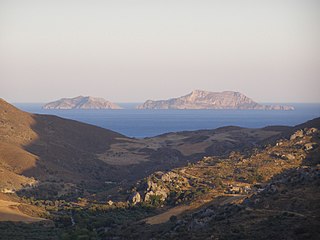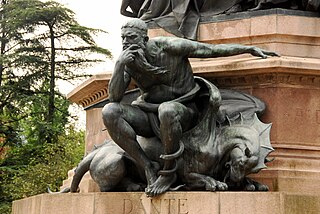Crete is a large island in Greece.
Contents
- Places
- Historical
- Places in the United States
- Other places
- People, figures, and, characters
- Other uses
- See also
Crete may also refer to:
Crete is a large island in Greece.
Crete may also refer to:

Crete is the largest and most populous of the Greek islands, the 88th largest island in the world and the fifth largest island in the Mediterranean Sea, after Sicily, Sardinia, Cyprus, and Corsica. Crete is located about 100 km (62 mi) south of the Peloponnese, and about 300 km (190 mi) southwest of Anatolia. Crete has an area of 8,450 km2 (3,260 sq mi) and a coastline of 1,046 km (650 mi). It bounds the southern border of the Aegean Sea, with the Sea of Crete to the north and the Libyan Sea to the south. Crete covers 260 km from west to east but is narrow from north to south, spanning three longitudes but only half a latitude.

In Greek mythology, Rhadamanthus or Rhadamanthys was a wise king of Crete. As the son of Zeus and Europa he was considered a demigod. He later became one of the judges of the dead and an important figure in Greek mythology.

In Greek mythology, Ariadne was a Cretan princess, the daughter of King Minos of Crete. There are different variations of Ariadne's myth, but she is known for helping Theseus escape from the Minotaur and being abandoned by him on the island of Naxos. There, Dionysus saw Ariadne sleeping, fell in love with her, and later married her. Many versions of the myth recount Dionysus throwing Ariadne's jeweled crown into the sky to create a constellation, the Corona Borealis.

In Greek mythology, the Cretan Bull was the bull Pasiphaë fell in love with, giving birth to the Minotaur.

The history of Crete goes back to the 7th millennium BC, preceding the ancient Minoan civilization by more than four millennia. The Minoan civilization was the first civilization in Europe.
The Pentozali or Pentozalis is the trademark folk dance of the island of Crete. It takes its name from the fifth (pente) attempt or step of the Cretan people to liberate Crete from the Ottoman Empire. It can thus be translated as "five-steps". The name also contains an element of wordplay, as ‘ζάλη’ means dizziness, and so it may also be interpreted as a dance that can make its dancers dizzy five times over ("five-dizzy"). In fact the dance has ten steps in total.
The music of Crete, also called kritika (κρητικά), refers to traditional forms of Greek folk music prevalent on the island of Crete in Greece. Cretan traditional music includes instrumental music, a capella songs known as the rizitika, "Erotokritos," Cretan urban songs (tabachaniotika), as well as other miscellaneous songs and folk genres.
In Greek mythology, Pylaemenes may refer to two distinct characters:

The Cretan Muslims or Cretan Turks were the Muslim inhabitants of the island of Crete. Their descendants settled principally in Turkey, the Dodecanese Islands under Italian administration, Syria, Lebanon, Palestine, Libya, and Egypt, as well as in the larger Turkish diaspora.
Aegean script or Cretan script refers to a group of scripts that originate from the island of Crete. It may also refer to:

The Cretan resistance was a resistance movement against the occupying forces of Nazi Germany and Fascist Italy by the residents of the Greek island of Crete during World War II. Part of the larger Greek resistance, it lasted from 20 May 1941, when the German Wehrmacht invaded the island in the Battle of Crete, until the spring of 1945 when they surrendered to the British. For the first time during World War II, attacking German forces faced in Crete a substantial resistance from the local population. In the Battle of Crete, Cretan civilians picked off paratroopers or attacked them with knives, axes, scythes, or even bare hands. As a result, many casualties were inflicted upon the invading German paratroopers during the battle. For their resistance to the Germans, the Cretan people paid a heavy toll in the form of reprisals.
Cretan Greek, or the Cretan dialect, is a variety of Modern Greek spoken in Crete and by the Cretan diaspora.
Syrtos is a traditional Greek dance in which the dancers link hands to form a chain or circle, headed by a leader who intermittently breaks away to perform improvised steps.

The Cretan State was established in 1898, following the intervention by the Great Powers on the island of Crete. In 1897, the Cretan Revolt led the Ottoman Empire to declare war on Greece, which led the United Kingdom, France, Italy and Russia to intervene on the grounds that the Ottoman Empire could no longer maintain control. It was the prelude to the island's final annexation to the Kingdom of Greece, which occurred de facto in 1908 and de jure in 1913 after the First Balkan War.

Gramvousa, also Grampousa, refers to two small uninhabited islands off the coast of a peninsula also known Gramvousa Peninsula in north-western Crete in the regional unit of Chania. The Gramvousa Peninsula forms the more westerly of the two pairs of peninsulae in northwestern Crete, and is the western part of Kissamos Bay.

Paximadia are two small uninhabited islands in the gulf of Mesara located approximately 12 km (7 mi) south of Agia Galini in Rethymno regional unit. They are in the Libyan Sea next to the southern coast of Crete. Due to their proximity to one another, the two islands appear as one from a distance.

The island of Crete was declared an Ottoman province (eyalet) in 1646, after the Ottomans managed to conquer the western part of the island as part of the Cretan War, but the Venetians maintained their hold on the capital Candia, until 1669, when Francesco Morosini surrendered the keys of the town. The offshore island fortresses of Souda, Grambousa, and Spinalonga would remain under Venetian rule until 1715, when they were also captured by the Ottomans.

In Greek mythology, the name Crete may refer to several figures, all of whom are associated with the homonymous island of Crete, and may have been considered its eponyms:
In Greek mythology, Cres was a possible eponym of the island Crete. Stephanus of Byzantium distinguishes between two figures of this name: one was a son of Zeus and the nymph Idaea, and the other a Cretan autochthon who became the first ruler of Crete. According to Cinaethon of Sparta, Cres was the father of Talos.
Cretan War may refer to multiple wars involving the island of Crete, including: